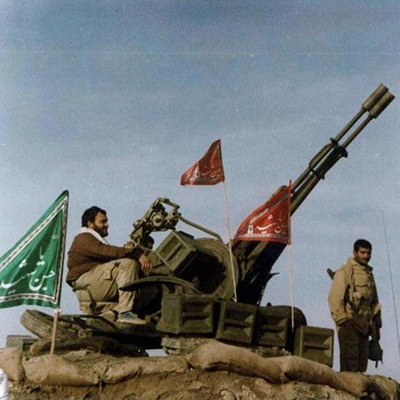Warfare
Air Defense Weapons and Systems
Written by: Mohsen Shirmuhammad,
Translated by: Hadi Qorbanyar
85 دورہ
During the eight-year Iran–Iraq War, air defense systems were widely used by both sides. In general, any weapon designed to target and destroy aerial objects such as airplanes, helicopters, missiles, or drones is considered an air defense weapon. They include surface-to-air missiles and anti-aircraft artillery. During the war, Iran possessed several types of surface-to-air missiles, such as the Sea Cat and Tiger Cat systems, the Rapier (all manufactured in the United Kingdom), the Hawk (made in the United States)[1], and the SAM-7[2] (produced by the Soviet Union).
The Hawk missile batteries[3]—known in Iran as Haag—were among the most significant air-defense weapons that were extensively used to counter enemy air raids during the Iran-Iraq War.[4] For instance, in Operation Valfajr 8 (the seizure of Al-Faw), 72 Iraqi aircraft were reportedly shot down by Hawk missiles.[5] However, the Hawk system was effective only at medium altitudes and could not engage high-flying aircraft such as the MiG-25.[6] Therefore, Iran received the Soviet-made SAM-2 via Libya[7] and the Chinese HQ-2 in 1984 and 1986, respectively.[8] One of the HQ-2’s most notable operational highlights was the downing of a MiG-25 over Isfahan on February 15, 1987.[9]
Early in the war, Iraq relied mainly on SAM-2, SAM-3, and SAM-6 surface-to-air missiles.[10] Its heavy and medium-range SAM batteries were deployed to intercept aircraft operating at medium to high altitudes.[11] In 1981, Iraq also received 30 Crotale missile batteries from France.[12]
Anti-aircraft artillery belongs to the class of short-range air defense systems, effective at ranges of less than four kilometers. These weapons form the closest and final defensive ring against enemy air attacks, protecting units, command centers, and logistical hubs.[13]
In 1968, Iran’s air defense forces acquired the 23 mm anti-aircraft gun from the Soviet Union,[14] with an effective range of 2,500 meters,[15] and later in 1971, the Swiss Oerlikon gun[16] with a range of 4,000 meters.[17] The 35 mm Oerlikon was known for its high rate of fire and rapid engagement capability against aircraft. However, its radar systems lacked sufficient power and precision, and aligning the gun with the radar took considerable time.[18]
The 23 mm gun, on the other hand, was lightweight, easy to operate, and simple to train crews on, features that made it widely adopted across various units.[19] In 1968, the Iranian Army[20] also purchased and deployed 57 mm self-propelled Shilka radar-guided guns (with a range of 8,800 meters)[21] and 23 mm guns[22] from the Soviet Union.[23]
Before the outbreak of the Iran–Iraq War, Iran had around 900 23 mm guns and 240 35 mm guns in active service.[24] At the beginning of the war, the country’s air defense forces operated 50 Oerlikon systems (each consisting of two 35 mm guns and one radar unit) and 300 23 mm guns.[25] On the other hand, the Iraqi army possessed 350 14.5 mm, 350 23 mm, and 200 57 mm anti-aircraft guns.[26]
Iran received 40 23 mm and 200 14.5 mm guns from North Korea,[27] with a range of 1,400 meters,[28] on October 28 and November 25, 1980, respectively. Initially deployed by the Iranian Army and the Islamic Revolutionary Guard Corps (IRGC), these 14.5 mm quad-barrel guns were later incorporated into the national air defense network.[29] With the capture of 135 anti-aircraft guns during the four operations of Thamen al-Aemmah (as), Tariq al-Quds, Fath al-Mubin, and Beit al-Muqaddas (1981–1982), the IRGC’s air defense units were established within both combat formations and independent operational groups.[30] Beginning in late April 1982, during Operation Beit al-Muqaddas, the Iranian Air Force deployed 10 Oerlikon batteries, along with 24 35 mm, 120 23 mm, and 22 14.5 mm guns. These were positioned alongside surface-to-air missile units and additional 23 mm and 57 mm guns from the Iranian Army Ground Forces to provide low-altitude air cover over the battlefield.[31]
In 1983, Iran acquired 400 23 mm guns from Bulgaria. However, due to a shortage of trained personnel—particularly non-commissioned officers qualified to lead 23 mm batteries—many of the guns were operated by regular conscripts.[32] In 1984, Iran bought 24 Skyguard systems (each consisting of two 35 mm guns, a radar unit, and related equipment)[33] from Switzerland.[34] With a range of 4,000 meters,[35] the Skyguard system offered fast reaction times against Iraqi aircraft and largely compensated for the inability of the 23 mm and 35 mm guns in engaging high-speed targets and operating under restricted visibility.[36] The Skyguard was even successful in intercepting Iraqi Exocet missiles over Kharq Island.[37]
The Bulgarian 23 mm guns were deployed around critical oil installations and wells that faced greater threat levels. In early 1984, 120 23 mm guns and 8 Oerlikon batteries were dispatched to the Persian Gulf islands, which were frequently targeted by Iraqi aircraft.[38]
In late 1984, Iraqi aircraft began flying in complete radio silence, making even limited intercept intelligence unavailable to Iran’s air defense in time. As a result, several 23 mm and 35 mm guns were mounted directly onto ship decks to deter enemy aircraft and protect both tankers and naval vessels.[39] Amid the Tanker War, the IRGC also installed 23 mm anti-aircraft guns on speedboats for retaliatory operations against Iraqi forces.[40]
In 1986, 22 Skyguard batteries from the Army Ground Forces—whose 35 mm guns had previously operated without radar support in southern operational zones—were transferred to the Air Defense Command and upgraded into fully integrated Skyguard systems with radar units.[41] In addition, 8 complete Skyguard batteries, alongside integrated 35 mm and 23 mm guns from both the Army and the IRGC, were deployed to defend the airspace over the Kharq Island.[42]
Throughout the war, both Iran and Iraq realized that anti-aircraft weapons and systems could be effectively repurposed as anti-personnel weapons, which led to their widespread deployment along the frontlines.[43]
In 1988, Iran’s air defense network covered 645 vital sites across the country. Depending on the importance of each location, the defensive setup ranged from 4 23 mm guns to as many as 8 Skyguard batteries and 40 various anti-aircraft guns.[44]
During the eight years of the Iran–Iraq War, the IRGC captured 446 anti-aircraft guns of different types,[45] and by the end of the war, Iran possessed a total of 2,800 anti-aircraft guns.[46] By contrast, Iraq, following the expansion of its air defense system, had 120 SAM-2, 150 SAM-3, and 25 SAM-6 as well as 60 Roland missile launchers.[47]After the war, Iran began developing various types of anti-aircraft guns and missiles domestically. For example, the Mesbah-1 anti-aircraft gun was produced in 2010,[48] followed by the Saeir in 2011.[49] Sayyad, Bavar 373, and Taer[50] are among the surface-to-air missiles manufactured in Iran.
[1] Goruh-e Ostadan-e Maaref-e Jang, Maaref-e Jang (War Studies), Tehran: Enteshaarat-e Iran-e Sabz, 1393, p. 362.
[2] Azghandi, Ali-Reza, Ravabet-e Khareji-ye Iran 1320–1357 (Iran’s Foreign Relations 1941–1979), Tehran: Qoumess, 1st ed., 1376, p. 324.
[3] Gholami, Baratali, Padaafand-e Havaaei – Seir-e Towseeeh va Takamol (Air Defense – Development and Evolution), Vol. 1, Tehran: Enteshaarat-e Iran-e Sabz, 1399, p. 81.
[4] Aslani, Yaqoub, Roket va Mooshakhaye Strategyk – Mooshakhaye Sath be Hava (Strategic Rockets and Surface-to-Air Missiles), Vol. 6, Tehran: Enteshaarat-e Sazman-e Aqidati Siyasi-ye Artesh, 1380, p. 33.
[5] Zahedi-Motlaq, Ebrahim, Shelik be Asemaan (Firing at the Sky), Tehran: Sooreh-ye Mehr, 1396, p. 246.
[6] Cordesman, Anthony va Abraham Wagner, Dars-haye Jang-e Modern – Jang-e Iran va Araq (Lessons of Modern War – The Iran–Iraq War), Vol. 2, trans. Hussain Yekta, Tehran: Nashr-e Marz-o-Boom, 1390, p. 383.
[7] Ahmadi, Muhammad-Ali, Atlas-e Padaafand-e Havaaei-ye Sepah dar Doran-e Defa Muqaddas (Air Defense Atlas of the IRGC during the Sacred Defense), Tehran: Markaz-e Asnad va Tahqiqat-e Defa Muqaddas, 1400, p. 178.
[8] Ibid., Pp. 182 and 184.
[9] Ibid., p. 190.
[10] Cordesman, Anthony va Abraham Wagner, Ibid., p. 381.
[11] Ibid., p. 382.
[12] Ibid., p. 381.
[13] Asadi, Heybatollah, Atash-e Tophkhaneh (Artillery Fire), Tehran: Enteshaarat-e DAFOS-e AJA, 1394, p. 298.
[14] Gholami, Baratali, Ibid., p. 44.
[15] Najafi-Rashed, Muhammad, Tophkhaneh dar Amaliyaat-haye Afandi va Mamuriyat-haye Vizheh (Artillery in Offensive Operations and Special Missions), Tehran: Iran-e Sabz, 1397, p. 644.
[16] Goruh-e Ostadan-e Maaref-e Jang, Ibid., p. 362.
[17] Ahmadi, Muhammad-Ali, Ibid., p. 22.
[18] Gholami, Baratali, Ibid., p. 50.
[19] Ibid., p. 51.
[20] Asadi, Heybatollah, Ibid., p. 308.
[21] Najafi-Rashed, Muhammad, Ibid., Pp. 645 and 446.
[22] Goruh-e Ostadan-e Maaref-e Jang, Ibid., p. 364.
[23] Gholami, Baratali, Ibid., p. 44.
[24] Ahmadi, Muhammad-Ali, Ibid., p. 33.
[25] Gholami, Baratali, Ibid., p. 81.
[26] Ahmadi, Muhammad-Ali, Ibid., p. 33.
[27] Gholami, Baratali, Ibid., p. 121.
[28] Najafi-Rashed, Muhammad, Ibid., p. 448.
[29] Goruh-e Ostadan-e Maaref-e Jang, Ibid., p. 362.
[30] Ahmadi, Muhammad-Ali, Ibid., p. 46.
[31] Gholami, Baratali, Ibid., Pp. 123–124.
[32] Ibid., p. 124.
[33] Jahanfar, Reza va Asghar Muhammadi-Fateh, Shenasaayi-ye Dastavardha va Noaavari-haye Padaafand-e Havaaei (Identifying Achievements and Innovations in Air Defense), Faslname-ye Elmi-ye Motaleat-e Defa Muqaddas, No. 19, Paeiz 1398, p. 128.
[34] Gholami, Baratali, Ibid., p. 126.
[35] Ahmadi, Muhammad-Ali, Ibid., p. 22.
[36] Jahanfar, Reza and Asghar Muhammadi-Fateh, Ibid., p. 135.
[37] Tafkik-e Vahdat Afarin (Unifying Differentiation), Mahname-ye Saf, No. 369, Shahrivar 1390, p. 29.
[38] Gholami, Baratali, Ibid., p. 180.
[39] Ibid., p. 183.
[40] Ahmadi, Muhammad-Ali, Ibid., p. 60.
[41] Gholami, Baratali, Ibid., p. 138.
[42] Ibid., p. 185.
[43] Ibid., p. 387.
[44] Gholami, Baratali, Ibid., p. 139.
[45] Ahmadi, Muhammad-Ali, Ibid., Pp. 328–329.
[46] Cordesman, Anthony va Abraham Wagner, Ibid., p. 390.
[47] Ibid., p. 381.
[48] Shekaarchi-ye Irani Mooshakhaye Dooshman ra Beshnaasid (Meet the Iranian Missile Hunters), Sait-e Donya-ye Eqtesad, 4 Esfand 1398, www.donya-e-eqtesad.com
[49] Tasavir | Anva-e Tophha-ye ZeddeHavaaei-ye Irani (Images | Types of Iranian Anti-Aircraft Guns), Hamshahri Online, 23 Khordad 1400, www.hamshahrionline.ir/news/607096
[50] Mooshakhaye Padaafandi-ye Iran az Marzhaye Enhesaari-ye Qodrat-haye Mashhoor-e Jahan Gozashtand (Iran’s Defensive Missiles Surpassed the Exclusive Borders of Global Powers), Mashregh News, 21 Tir 1401, www.mashreghnews.ir/news/1394810



